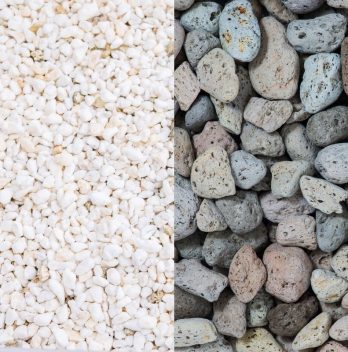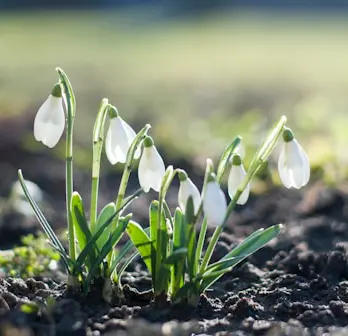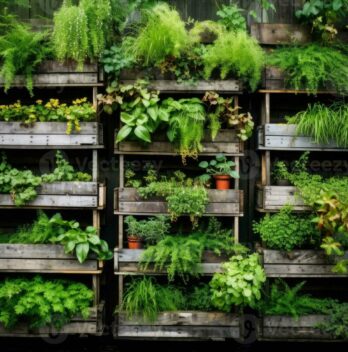Let’s talk about perlite vs pumice. Both perlite and pumice are great
There are some factors to consider that will help determine if perlite is better than pumice and vice versa. So, read on to find out more about these two materials.
Perlite & Pumice
Perlite and pumice are both used to enhance
First things first, let’s take a look at the characteristics and features of both so we can better understand them. It’s good you understand what they are made of and where they came from so you can decide which is better.

Perlite Features & Uses
Perlite is derived from a mined silicon rock that has been crushed, heated, and expanded. It also contains other minerals like iron oxide, potassium oxide, and sodium oxide.
Perlite is light in weight and color. Before the process of heating, perlite can be brown, red, gray, green, or blue. However, after it has been heated, it becomes light gray or white.
Perlite is commonly used in ceiling tiles, roof insulation, and for plastering. In addition to these household and industrial uses, they are also used in gardening and hydroponics. It is also a great choice for seedling starters as well as root cuttings.
Pumice Features & Uses
Pumice is derived from volcanic eruptions or explosions. It comes from the same type of molten rock that would form granite. Pumice requires much less processing than perlite, so its production is more environmentally friendly.
Pumice is quite soft but not as lightweight as perlite. It is usually referred to as solidified rock foam. Pumice rocks are capable of floating in the water as they contain some air that makes them light enough to float.
Pumice is mostly used for construction and horticulture. Unlike regular concrete blocks, the concrete block that has pumice has a lighter weight and enhanced insulating features. They are used in the garden as
Pumice is especially great for plants that are heavy and predisposed to turning over in the water, as it will keep them rooted in one place.
Perlite Vs Pumice
Let’s compare some features between perlite vs pumice to know our best pick:
- The pumice stone comes in various sizes to suit various requirements and they are lightweight but not as lightweight as perlite.
- Pumice is capable of floating but it is still a little heavier than perlite so it can’t be blown away by wind or storm, unlike perlite.
- Heavy potted plants that are prone to tipping over are better off planted in pumice rather than perlite to keep them steady. Thus, your plants are safe from wind, heavy rain, as well as routine watering.
- Unlike perlite, pumice does not decompose easily. This implies it can last you for a long time without the need for replacement thus, reducing running costs.
- Perlite is not as pricey as pumice. It’s easier to purchase them at your local garden center or nursery.
- Perlite is also easy to access, however, pumice might be expensive in your zone and it might be difficult to get the appropriate sizes that you need. Mostly, bigger sizes of pumice are common. However, smaller sizes may not be always available. The good news is that there are various retailers online where you can obtain the appropriate type and size that you want. All you need to do is to pay a bit for the shipping fee and have your pumice delivered comfortably to your doorstep.
Pumice vs Perlite For Indoor Plants
Both pumice and perlite are excellent for improving
Both products are used for different purposes in indoor gardens. Pumice is better suited for tropical plants that need to retain water, while perlite works better for plants like orchids as a
Pumice and perlite will improve the following
- soil drainage
- soil aeration
In terms of having particle size options to fit the size of your indoor plant pots or planters, perlite offers more options. Other advantages of perlite include that it is more readily available for purchase, as well as that it is stable and will not disintegrate over time or release any chemicals into the
Unless you absolutely have to use pumice, we would recommend perlite as our amendment of choice due to the many advantages and choices that it offers.
What is Perlite Made Of?
Perlite is a naturally occurring mineral. It exists as a type of glass in nature, that is formed when volcanic obsidian glass is saturated with water, a process that happens over a long period.
Like all other volcanic rock, it is pretty dense and heavy in its natural form. Typical perlite is made up of the following ingredients;
- 70-75% silicon dioxide
- Aluminum oxide
- Sodium oxide
- Potassium oxide
- Iron oxide
- Magnesium oxide
- Calcium oxide
- 3-5% Water
Before the use of pumice in plants, it has to be processed into the light stuff that we see, which looks like styrofoam.
What is Pumice Made Of?
Pumice is also a type of volcanic glass. It is very porous and is formed when there are explosive volcanic eruptions. The high porous nature of the pumice is caused by depressurization and rapid cooling after the lava gets ejected from the volcano.
Pumice in its natural form has colors that range from white to dark grey, depending on the place where it is mined. Some gardeners use pumice as a top dress for their
Pumice Or Perlite For Succulents?
Both pumice and perlite can be used for succulents. However succulents like pumice more. This is because pumice absorbs and releases water slowly while helping aerate the roots through the
If you are using organic
Pumice is also a bit heavier than perlite. It will work better for top-heavy plants like some succulents by helping to stabilize them. Because it is heavier, it also means that there will be less waste as you will not use much product through wind, rain, and routine watering.
Perlite Vs Pumice: The Option Chosen
Even though the two are great, we still have one clear winner. So, our pick is pumice! Pumice is an excellent option especially in enhancing the soil in your succulent.
Conclusion – Perlite Vs Pumice
Both perlite and pumice are great for
However, pumice is of greater option because it is long-lasting, doesn’t decompose easily, will hold your heavy plant steady, and so on. The main downside to pumice is that it’s a bit more pricy than perlite, and not as easily accessible.
All in all, you should go for the one that will suit your needs and plants best.
FAQ’s
What’s the difference between pumice stone and perlite?
Pumice is a volcanic rock that contains many small air pockets. It can be used as a light weight, inexpensive, effective insulation material. Perlite is a lightweight, expanded, non-combustible glassy volcanic rock with excellent insulating properties. Both are used for insulation in building construction. Pumice is often used as a form of insulation because it is soft and easy to work with.
The most common use of pumice is in the production of lightweight building materials. These include lightweight concrete blocks and panels. Pumice is also used as an aggregate in asphalt. It is also used for decorative purposes in garden and outdoor applications. When pumice is combined with water, it becomes a hydraulic cement.
Pumice is pretty good but if you get it from the hardware store it’s often dusty and has grit in it. It’s not as fine as perlite.The grit can be dangerous in certain applications so I’d avoid using it unless you have to.
Perlite is much finer than pumice. It is also naturally non-toxic. You’ll need to test it with a magnet and a metal detector. If you find any iron or other metals, then don’t use it. It could give off harmful fumes when burned.
Can I use pumice instead of perlite?
Yes, it is possible. Pumice has a higher water content than perlite, so you may need to increase the amount of fertilizer you use. Pumice has a low level of nutrients, so you will need to fertilize your plants. It also doesn’t contain any harmful chemicals. You can use pumice as a soil conditioner, too. Pumice is one of the best soils for growing plants.
Pumice is used to create a rich, fertile soil by adding it to topsoil. It is said to improve drainage and to prevent the collapse of the soil structure.
It is also used as a mulch for plants that prefer cooler temperatures, such as strawberries, tomatoes, and peppers.
Pumice is a great material for weed prevention. It keeps the soil loose and aerated, which helps to keep weeds from growing. If you are having problems with weed growth, try using pumice.
Is pumice better than perlite?
I have used both, and they work about the same. They both will absorb water, and they both are fine.
The only difference is that perlite absorbs water more quickly than pumice, so if you’re starting a seedling from seed, use pumice instead of perlite. You can also buy hydroponic soil mix. It comes in a bag with nutrients already added. You’ll probably want to add some fertilizer as well, but that’s up to you.

Eunice is an enthusiastic gardener with a passion for growing beautiful flowers. She loves nothing more than spending time in her garden, tending to her plants and enjoying the outdoors. Eunice has been gardening for over 15 years and has developed a unique style of landscaping that is both practical and aesthetically pleasing. She is especially fond of growing roses and enjoys experimenting with different varieties and colors. Eunice takes great pride in her garden and often shares the fruits of her labor with friends and family. In her spare time, she enjoys reading gardening magazines and attending local horticulture events. Eunice is passionate about her hobby and is always eager to share her knowledge and experience with others.





